Construction the skeleton of a singularity
Skeletons for nodes
In the normal form of an A1 singularity, $F(x,y,z)=x^2+y^2-z^2$, two of the three partial derivatives $\frac{\partial F}{\partial x} = 2 x$ (in red), $\frac{\partial F}{\partial y} = 2 y$ (in green), $\frac{\partial F}{\partial z} = 2 z$ (in blue), intersect the surface in pairs of lines passing through the singular point.
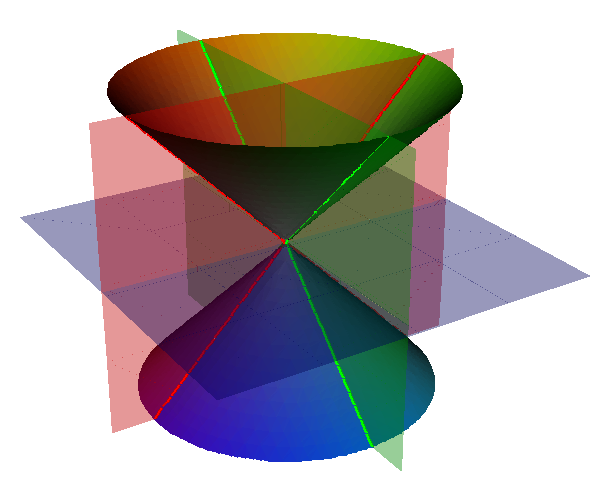
We can use the intersection of the surface with the three partial-derivative surfaces to help triangulate the surface. As all three derivatives vanish at a singularity we know that the partial derivative surfaces and hence the intersections will pass through the any singularities.
- Definition
- The skeleton of an implicit curve is the union of the three varieties $\mathbf{V}\left(F,\frac{\partial F}{\partial x}\right)$, $\mathbf{V}\left(F,\frac{\partial F}{\partial y}\right)$, $\mathbf{V}\left(F,\frac{\partial F}{\partial z}\right)$. The skeleton is further divided into three sets x-skeleton: $\left\{(x,y,z) : F(x,y,z)=0, \frac{\partial F}{\partial x} = 0\right\}$, y-skeleton: $\left\{(x,y,z) : F(x,y,z)=0, \frac{\partial F}{\partial y} = 0 \right\}$, z-skeleton: $\left\{(x,y,z) : F(x,y,z)=0, \frac{\partial F}{\partial z} = 0 \right\}$.
Including points on the skeleton help produce a good polygonization around the singular point.
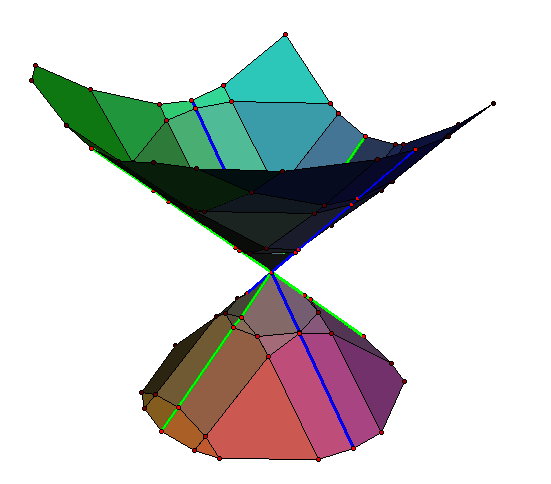
For the A1 normal form two sets of edges of the skeleton pass through the singular point, but is this always the case? If we rotate the surface and then calculate the partial derivatives are there always parts of the skeleton that pass through the singular points?
It turns out that this is not always the case. It is possible to find varities where either 0, 1, 2 or 3 of the partial derivatives form part of the skeleton.
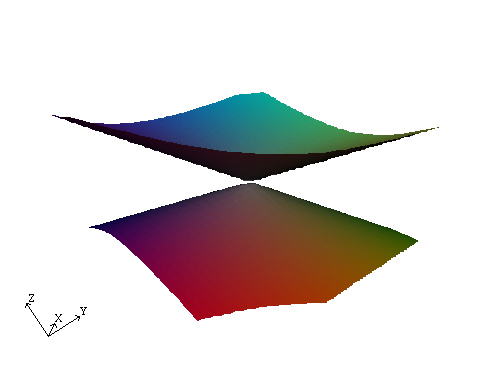
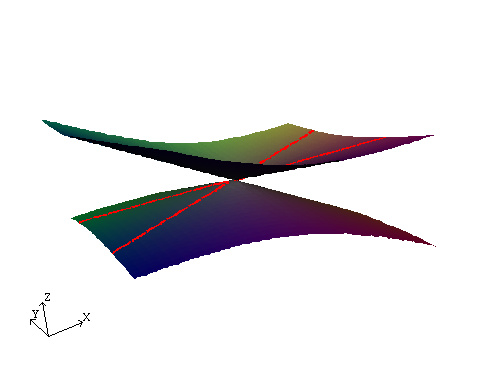
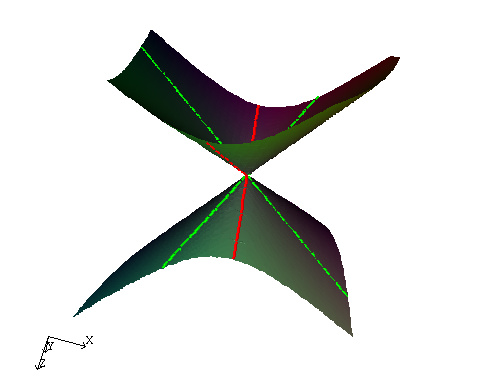
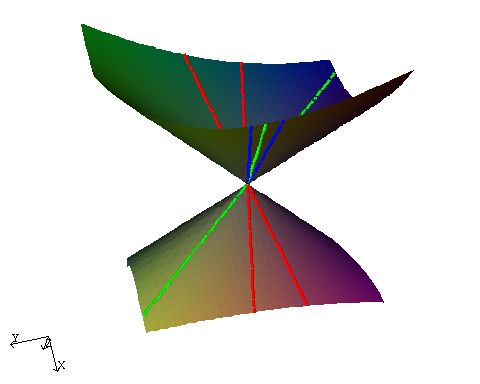
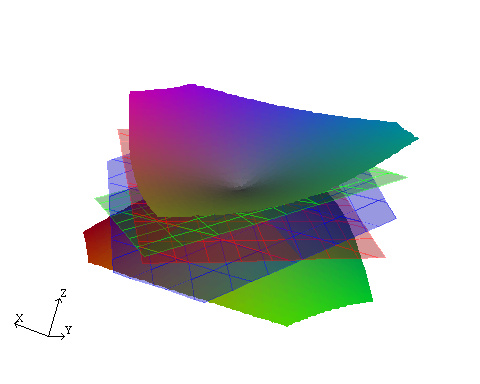
Quadratic forms
$F(x,y,z)$ can be treated as ternary quadratic form. If $F$ is positive definite or negative definite then $F(x,y,z)\ne 0$ for all $(x,y,z)\ne 0$, and the surface consists of a single isolated point. If the matrix of coefficients $M$ has determinant zero the quadratic form is degenerate and the surface consists or two intersecting planes. Hence we are only interested in non-degenerate indeterminate forms, that have signatures +1 or -1.
If $M$ is positive definite then $a\gt 0, d\gt 0, f\gt 0$. By the Sylvester's criterion its necessary and sufficient that $a\gt 0$, $a d - b^2 \gt 0$, $|M|\gt 0$.
If $M$ is negative definite then $a\lt 0, d\lt 0, f\lt 0$. its necessary and sufficient that $a\lt 0$, $a d - b^2 \gt 0$, $|M|\lt 0$.
Impact on the algorithm
The case where none of the derivative planes intersect poses problems for the algorithm. Normally the algorithm find the intersection of the surface with the boundary of a box and also any singular points inside the box. It then attempts joining points on the boundary to the singularity along parts of the skeleton. When the skeleton is empty this is not possible and the singularity is not correctly linked, note how in the image above with zero derivative the surfaces does not contain the singular point, instead it has two disconnected components.
This problem can be overcome by notionally rotating the surface, calculating derivatives, and then rotating back. This is equivalent to calculating the intersection with surfaces like $\frac{\partial f}{\partial x} - \frac{\partial f}{\partial x} = 0$,
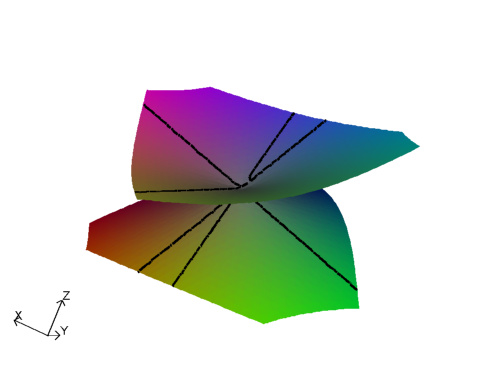
With this enhanced skeleton, consisting of intersections with nine surfaces, $\frac{\partial f}{\partial x}=0$, $\frac{\partial f}{\partial y} = 0$, $\frac{\partial f}{\partial z} = 0$, $\frac{\partial f}{\partial x} \pm\frac{\partial f}{\partial y} = 0$, and $\frac{\partial f}{\partial x} \pm\frac{\partial f}{\partial z} = 0$, and $\frac{\partial f}{\partial y} \pm\frac{\partial f}{\partial z} = 0$ it should hopefully always produce sufficient segments to nicely triangulate an A1 singularity.
Conditions for point on a skeleton
Consider the variety $F(x,y,z) = a x^2 + 2 b x y + 2 c x z + d y^2 + 2 e y z + f z^2 = 0$, the three partial derivative are $\frac{\partial F}{\partial x} = 2 a x + 2 b y + 2 c z$, $\frac{\partial F}{\partial y} = 2 b x + 2 d y + 2 e z$, $\frac{\partial F}{\partial z} = 2 c x + 2 e y + 2 f z$. To find the x-skeleton, with $\frac{\partial F}{\partial x}=0$, substitute $y = -\tfrac{a}{b}x -\tfrac{c}{b}z$, with $b\ne0$, into $F=0$ giving $$a x^2 + 2 b \left(-\tfrac{a}{b} x - \tfrac{c}{b} z\right) x + 2 c x z + d \left(-\tfrac{a}{b} x - \tfrac{c}{b} z\right)^2 + 2e \left(-\tfrac{a}{b} x - \tfrac{c}{b} z\right) z + f z^2=0.$$ Multiply through by $b^2$ and find the coefficients of the quadratic in $x$ and $z$, $$(a^2 d - a b^2 ) x^2 + 2 (a c d - a b e ) x z + ( b^2 f - 2 b c e + c^2 d ) z^2=0.$$ The discriminant is $$\begin{align} 4 &( a c d - a b e )^2 - 4 (a^2 d - a b^2 )( b^2 f - 2 b c e + c^2 d ) \\ &= 4 a b^2 (-a d f + a e^2 + b^2 f - 2 b c e + c^2 d) \\ &=-4 a b^2 |M|\end{align}$$ Divide by the square term and set $\Delta_x = -a\ | M |$. The x-skeleton will have two branches if $\Delta_x\gt0$, a degenerate line when $\Delta_x=0$ and have just a single point if $\Delta_x\lt 0$. $\Delta$ changes sign when either the $a$ or the determinant changes sign. There are similar conditions $\Delta_y=-d\ |M|\gt0$, $\Delta_z=-f\ |M|\gt0$, for whether the y-skeleton and z-skeleton respectively have branches.
In Figure 3 above all cases has $|M|\lt0$, in Fig 3a, $a\lt0, d\lt0,$ and $f\lt0$ so $\Delta_x \lt0, \Delta_y\lt0$, and $\Delta_z\lt0$ and the x-skeleton, y-skeleton and z-skeletons all consist of a single point. The other cases show the effect of $a$, $d$ and $f$ changing sign.
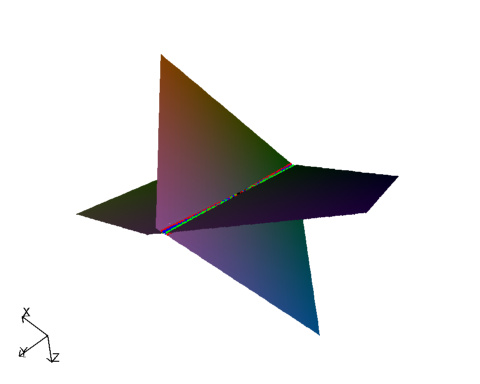
Next consider the variety $V\left(F=0, \frac{\partial F}{\partial x} + \frac{\partial F}{\partial y}=0\right)$ $$\frac{\partial F}{\partial x} - \frac{\partial F}{\partial y} = 2(a x + b y + c z) - 2(b x + d y + e z) = 2(a-b)x + 2(b-d)y + 2(c-e)z.$$ Assume $e-c\ne 0$ and set $z = \frac{a-b}{e-c} x + \frac{b-d}{e-c}y$, substitute into $F=0$ $$a x^2 + 2 b x y + 2 c x \left(\frac{a-b}{e-c} x+\frac{b-d}{e-c} y\right) + d y^2 + 2 e y \left(\frac{a-b}{e-c} x+\frac{b-d}{e-c} y\right) + f \left(\frac{a-b}{e-c} x+\frac{b-d}{e-c} y\right)^2 $$ multiply through by $(e-c)^2$ $$a (e-c)^2 x^2 + 2 b (e-c)^2 x y + 2 c (e-c) x \left((a-b) x+(b-d) y\right) + d (e-c)^2 y^2 + 2 e (e-c) y \left((a-b) x+(b-d) y\right) + f \left((a-b) x+(b-d) y\right)^2 $$ expand and collect terms $$\begin{align} &( -2 a b f+a e^2+a^2 f+2 b c^2+b^2 f-a c^2-2 b c e) x^2 \\ &+ ( 2 a b f+2 a e+2 b d f+2 b e^2+2 c^2 d-2 a d f-2 b c e-2 b e-2 b^2 f-2 c d e ) x y\\ &+ (-2 b d f+2 b e+b^2 f+c^2 d+d e^2+d^2 f-2 c d e-2 d e ) y^2 \\ &= 0 \end{align}$$ the descriminant is $$ \begin{align} (&2 a b f+2 a e+2 b d f+2 b e^2+2 c^2 d-2 a d f-2 b c e-2 b e-2 b^2 f-2 c d e )^2 \\ &\quad- 4 ( -2 a b f+a e^2+a^2 f+2 b c^2+b^2 f-a c^2-2 b c e) (-2 b d f+2 b e+b^2 f+c^2 d+d e^2+d^2 f-2 c d e-2 d e ) \\ & = -4 (a + d - 2 b) (e-c)^2 ( a d f + 2 b c e - a e^2 - d c^2 - f b^2) \\ & = -4 (a + d - 2 b) (e-c)^2 | M| \end{align} $$ Set $\Delta_{x-y} = - (a + d - 2 b) |M|$, similar expressions can be used to check other parts Set $\Delta_{x+y} = - (a + d + 2 b) |M|$, Set $\Delta_{x-z} = - (a + f - 2 c) |M|$, Set $\Delta_{x+z} = - (a + f + 2 c) |M|$, Set $\Delta_{y-z} = - (d + f - 2 e) |M|$, Set $\Delta_{y+z} = - (d + f + 2 e) |M|$, even this set does not always produce non trivial skeletons. With $a=-0.2, b =0.1, c=-0.5, d=-0.46, e=0.26, f=-0.10$ All the varieties above are trivial.
Next consider the variety $V\left(F=0, \frac{\partial F}{\partial x} + \frac{\partial F}{\partial y} + \frac{\partial F}{\partial z}=0\right)$ $$ \begin{align} \frac{\partial F}{\partial x} + \frac{\partial F}{\partial y} + \frac{\partial F}{\partial z} &= (2 a x + 2 b y + 2 c) + (2 b x + 2 d y + 2 e z) + (2c x + 2 e y + 2 f z) \\ &= (2 a + 2 b + 2 c) x + (2 b + 2 d + 2 e) y + (2 c + 2 e + 2 f) z \end{align}$$ set $z= \frac{-1}{2 c + 2 e + 2 f} ( (2 a + 2 b + 2 c) x + (2 b + 2 d + 2 e) y )$ substitute into $F$ and calculating the discriminant we obtain the condition $\Delta_{x+y+z} = - (a+d+f+2b+2c+2e) |M|$. $\Delta_{x+y-z} = - (a+d+f+2b-2c-2e) |M|$. $\Delta_{x-y+z} = - (a+d+f-2b+2c-2e) |M|$. $\Delta_{x-y-z} = - (a+d+f-2b-2c+2e) |M|$. This still fails with $a=-0.23, b=0.49, c=-0.41, d=-0.95, e=0.78, f=-0.63$ all above test fails.
